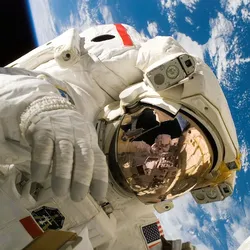
Level 1:
A special spaceship named OSIRIS-REx went to a big rock called Bennu in space. It picked up some of the rock and brought it back to Earth. This special rock might tell us about how our world started. But some important people need to look at it first. OSIRIS-REx will now go to another big space rock.
Highlighted vocabulary words:
- OSIRIS-REx: The name of the spaceship that went to Bennu.
- Bennu: A big rock in space where the spaceship got some pieces to bring back to Earth.
Level 2:
NASA sent a spacecraft called OSIRIS-REx on an important space journey. It went to a big rock in space named Bennu. The spacecraft used a robotic arm to pick up a part of the rock. It carried this special dust and rock back to Earth. Scientists are excited because they think this space rock might tell us about the beginning of our universe. Now, OSIRIS-REx is going to visit another space rock named Apophis.
Highlighted vocabulary words:
- Spacecraft: A vehicle made for traveling in space.
- Robotic arm: A machine part which moves and works like a human arm.
Full Story:
NASA’s OSIRIS-REx spacecraft has made history by executing a challenging mission to gather and transport the largest-ever haul of asteroid material back to Earth. Following a multi-year journey, the mission’s precious cargo, microscopic rocks and dust from asteroid Bennu, parachuted gently to Earth, landing in the Utah desert.
OSIRIS-REx, or Origins, Spectral Interpretation, Resource Identification, Security-Regolith Explorer, was launched in 2016 for the bold venture of traveling to the asteroid Bennu. Upon reaching the asteroid in 2018, the spacecraft spent the next two years studying the formation, which is dark-colored and diamond-shaped.
The critical highlight of the mission was when the spacecraft extended its robotic arm down towards the rocky surface of the asteroid, which subsequently emitted a puff of gas. This gas caused an upspring of dust and rocks, some of which got drawn into the spacecraft’s collection mechanism.
However, the operation was not without its challenges. OSIRIS-REx’s fist bump with Bennu caused some rocks to get lodged in the collection mechanism. A few of the smaller pebbles managed to escape, evoking feelings of heartbreak and disappointment for the team overseeing the mission.
Nevertheless, the researchers rejoiced upon realizing that the spacecraft managed to gather around 250 grams of rocks and dust. This is the largest amount of material ever successfully transported back from an asteroid, eclipsing the previous record held by the Japan Aerospace Exploration Agency (JAXA) of 5.4 grams.
Now that the asteroid particles are on Earth, the NASA curation team has sprung into action. The team’s objectives involve delicately disassembling the storage container and initiating a comprehensive analysis of the materials gathered. Researchers are optimistic that the pristine samples hold potential clues to the origins of the Solar System. The samples will be kept in an atmosphere of pure nitrogen to minimize the risk of contamination. This ensures that the asteroid’s geology and chemistry, preserved over billions of years, remain intact.
This mission targeted Bennu because it is a carbon-rich asteroid. The material collected by OSIRIS-REx potentially contains organic compounds. These carbon-based molecules, ubiquitous in many meteorites, are capable of engaging in sophisticated chemical reactions, including those that give rise to life. This, combined with the preservation of the sample, sets the stage for thorough and reliable scientific analysis.
However, threats to the mission still loom, particularly from potential government shutdowns. Congress remains embroiled in a battle over federal budget priorities. A stalemate could lead to shutdowns of federal agencies, including NASA. If this happens, the highly anticipated analysis of Bennu’s sample could face delays. Despite this, there is a steadfast resolve to ensure that the sample remains safe and the mission’s objective gets achieved as planned.
Meanwhile, the bold journey of the OSIRIS-REx spacecraft continues. Having successfully deposited its sample-return capsule on Earth, the spacecraft is charting its way towards the investigation of another asteroid, known as Apophis, which has a contrasting stony chemical composition.
To sum up, NASA’s OSIRIS-REx mission has indeed unfolded an exciting chapter in space exploration by successfully delivering the largest-ever asteroid sample back to Planet Earth. The mission stands as a testament to human curiosity, resilience, and technological sophistication. It is now up to the scientists on Earth to unveil the secret treasures that this asteroid sample may hide.
Highlighted Vocabulary:
-
NASA’s OSIRIS-REx spacecraft: NASA stands for the National Aeronautics and Space Administration, and OSIRIS-REx is a spacecraft designed to study and collect samples from the asteroid Bennu.
-
Precious cargo: Valuable or important items being transported, often with great care and attention.
-
Bold venture: A daring or risky undertaking or mission.
-
Critical highlight: An essential or significant aspect that deserves special attention or emphasis.
-
Robotic arm: A mechanical appendage controlled by a computer or operator to perform tasks, often used in space missions for various operations.
-
Fist bump: A gesture in which two people lightly tap their closed fists together as a sign of agreement, greeting, or celebration.
-
Heartbreak: Intense emotional pain or sorrow, typically associated with the loss of something cherished or loved.
-
Pristine samples: Samples that are in their original, untouched condition, without any contamination or alteration.
-
Pure nitrogen: Nitrogen gas that is free of impurities or other gases, often used in various industrial and scientific applications.
-
Carbon-rich asteroid: An asteroid that contains a significant amount of carbon-based materials or compounds.
-
Preservation: The act of maintaining something in its original state or condition, often to protect it from deterioration or decay.
-
Scientific analysis: The process of examining and studying data, materials, or phenomena to gain a better understanding of their properties, characteristics, and implications.
-
Highly anticipated: Something that is eagerly expected or awaited with great interest or excitement.
Questions:
Question: Why was the Bennu asteroid chosen as the destination for the OSIRIS-REx mission?
Answer: The Bennu asteroid was chosen for the OSIRIS-REx mission because it is a carbon-rich asteroid. This means that its rocks might contain organic compounds, which are carbon-based molecules found in many meteorites. These are of interest because they are essential for many types of chemical reactions that led to life.
Question: How does the approach to preserving the samples from Bennu contribute to their value for scientific study?
Answer: The preservation approach involves storing the Bennu samples in an environment of pure nitrogen soon after the landing. This reduces the potential for contamination, which is crucial because it allows for a more accurate study of the asteroid’s original geology and chemistry, as it would have been preserved since the formation of the Solar System.
Question: Do you think resources should continue to be invested in studying asteroids for clues to the solar system’s origin?
Answer: In my opinion, yes, resources should continue to be invested in studying asteroids. These celestial bodies could hold clues to the very existence and development of our Solar System. Understanding our past could provide critical insights into our future and the possibilities it might hold.
Question: What impact might a government shutdown have on the study of the retrieved samples?
Answer: If the government shuts down due to a funding deadlock, it could delay the analysis of the Bennu samples. This won’t affect the samples’ safety, but it might postpone the revealing of important scientific discoveries. It’s a reminder of how politics and science are often intertwined.
Fill in the Blanks:
- The mission was executed by ___________, a spacecraft sent by NASA.
- The collection of rocks and dust brought back from Bennu is referred to as ___________.
- The mission was seen as a ___________ because of the complexity and risks involved.
- The ___________ of the mission was when the spacecraft extended its robotic arm to the rocky surface of the asteroid.
- With the use of its ___________, the spacecraft was able to gather the dust and rocks kicked up on the asteroid’s surface.
- ___________ was expressed by the team when some of the gathered material escaped the collection mechanism.
- The collected samples are kept in an atmosphere of ___________ to reduce the potential for contamination.
- The ___________ samples are like a time capsule, offering insights into the Solar System’s past.
- It’s hoped that Bennu’s samples contain ___________ compounds, the building blocks of many types of chemistry.
- The ___________ of the sample, from collection to analysis, ensures the reliability of the scientific results.
- The return of the capsule and the subsequent analysis of the samples from Bennu are ___________ events in the scientific community.
Words: OSIRIS-REx, precious cargo, bold venture, critical highlight, robotic arm, heartbreak, pure nitrogen, pristine, carbon-rich, preservation, highly anticipated.
Mini Test: Comprehension Check on NASA’s OSIRIS-REx Mission
Question 1
What was the mission of the NASA’s spacecraft OSIRIS-REx?
a) To travel to Mars and study its surface
b) To collect dust and rocks from the asteroid Bennu
c) To take photos of outer space
d) To study the Moon’s surface
Question 2
Why was this mission important?
a) It provided a chance to see an asteroid up close
b) It collected the largest-ever haul of asteroid material
c) It was a test for a new kind of spacecraft
d) It was the first mission to Mars
Question 3
What challenges did OSIRIS-REx encounter during the mission?
a) All of its fuel was used up
b) Pieces of rock got jammed in the collection mechanism
c) It got lost in space
d) It was hit by another asteroid
Question 4
What was special about the asteroid Bennu that the spacecraft OSIRIS-REx visited?
a) It was the largest asteroid ever discovered
b) It was a carbon-rich asteroid
c) It was moving towards Earth
d) It had an atmosphere similar to Earth’s
Question 5
What could potentially delay the scientific study of the samples collected by OSIRIS-REx?
a) Contamination from Earth’s atmosphere
b) A U.S government shutdown
c) Technical issues with the scientific equipment
d) Unavailability of scientists
Question 6
After delivering the samples to Earth, what will OSIRIS-REx do next?
a) It will fly back to Bennu to collect more samples
b) It will visit another asteroid named Apophis
c) It will return to its launch station for repairs
d) It will fly into the Sun
Match the Words
Match the following vocabulary words with their meanings:
- OSIRIS-REx
- Precious cargo
- Robotic arm
- Carbon-rich asteroid
- Heartbreak
- Pure nitrogen
- Pristine
a) Unspoiled, kept in its original state
b) An asteroid containing a high amount of carbon
c) The mechanism used by the spacecraft to collect samples
d) Clean, uncontaminated gas where samples are stored
e) NASA’s spacecraft that went to Bennu
f) Valuable collection of rocks and dust from Bennu
g) Great sadness or disappointment
Answers
Question 1 - b, Question 2 - b, Question 3 - b, Question 4 - b, Question 5 - b, Question 6 - b,
Match the Words - 1e, 2f, 3c, 4b, 5g, 6d, 7a.




